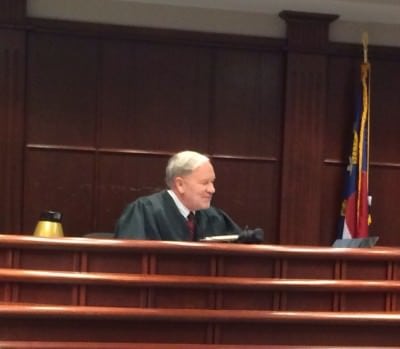A parade of charter school leaders came before the Joint Legislative Task Force on Education Finance Reform Thursday and asked lawmakers to stop shortchanging charter schools when it comes to funding.
Pamela Blizzard who led the founding of Research Triangle High School in Research Triangle Park began the day by telling legislators that her school gets about $2,100 less per student than Durham Public Schools. Sen. Jerry Tillman, R-Randolph, was sympathetic to her plea but said she needed to provide more specific information.
“Other than the facility money, I want to know what the difference is,” he said, adding later: “I’ve been working for a number of years to get the funding equal,” he said. “And I want to get you on a level playing field.”
Specifically, he wanted to know what, other than facility money — which charter schools do not get — is different between funding for her school and traditional public schools.
It was not a question she could answer, and Rep. Hugh Blackwell, R-Burke, reiterated Tillman’s point.
“This complaint has been with us for years,” he said. “I think it’s critical that rather than put up differences like that…that people be prepared to explain what the difference is, so that we can deal with the difference.”
Blizzard apologized to Blackwell for not having the details he needed.
But her presentation was just the start, as several charter leader came before the lawmakers and said that funding for charter schools was inequitable when compared to traditional public schools.
Ann Walters, headmaster of Union Academy Charter School in Union County, focused in particular on how funds make their way to charter schools. They are given to the school district first which then distributes them to charters.
She made an analogy of an older brother and a younger sister both raking the yard. The older brother has been at it all day, and the younger sister joins in for only about an hour. And then at the end of the day, the brother is given $10 but told he has to give $3 to his sister.
“That’s what our local LEAs (Local Education Agencies) feel like right now,” Walters said. “That’s the animosity that this system creates.”
Walters and her colleague Lynn Kroeger, chief financial officer for the school, criticized the current state education funding model and championed a system where the money follows the student.
Those complaints mirror the conversation that sparked the creation of the task force. A Program Evaluation Division report found problems with the current allotment system and suggested that it needed to be fixed or the state should move to a weighted-student formula, where the money follows the student.
Heather Vuncannon, the superintendent of Uwharrie Charter Academy in Randolph County, laid out other ways in which the division of funding between charters and traditional public schools is unfair, including the fact that traditional public schools get money for facilities and charter schools do not.
Most money for facilities in school districts comes not from the state but from the county commissioners. Vuncannon said public charter schools use 20 percent of their per-pupil funding on facilities, creating an inequity in per-pupil spending. She argued that county commissioners should be allowed to give capital funding to charter schools if they want. They are not presently permitted to make that allocation.
Rep. Frank Iler, R-Brunswick, began his response to Vuncannon by stating that one of the things that was so attractive to the state about charter schools is that they did not get facility funding from the government. He went on to say that he was not sure county commissioners would want to spend extra money on charter schools, but it was an option to allow them to do so.
Vuncannon said that all pots of education money should be examined for equitable distribution between all schools, including charters. She also said public school districts are often tardy in turning over the money that belongs to charters.
Tillman was surprised to hear that.
“That needs to be fixed, and this committee ought to be able to fix that,” he said.
Robert Brown, headmaster of Pinnacle Classical Academy in Shelby, said that the inequitable funding between charters and traditional public schools creates a huge problem in North Carolina education.
“It’s created what I call a two-tiered school system,” he said. “It’s one of haves and have-nots.”
He said, amongst other things, he has a difficult time hiring veteran teachers and staff.
He, like many of the presenters, favored a funding system where money follows the student, saying it would prevent the shortchanging of charter schools.
Blizzard pointed out in her presentation some of the things she liked about how charters get money, including flexibility to use state money as they see fit. Public school leaders often ask for this type of flexibility.
“We have control over that,” she said of the block grant funding charters receive. “So it’s a wonderful, real thumbs-up plus for us.”
Recommended reading




